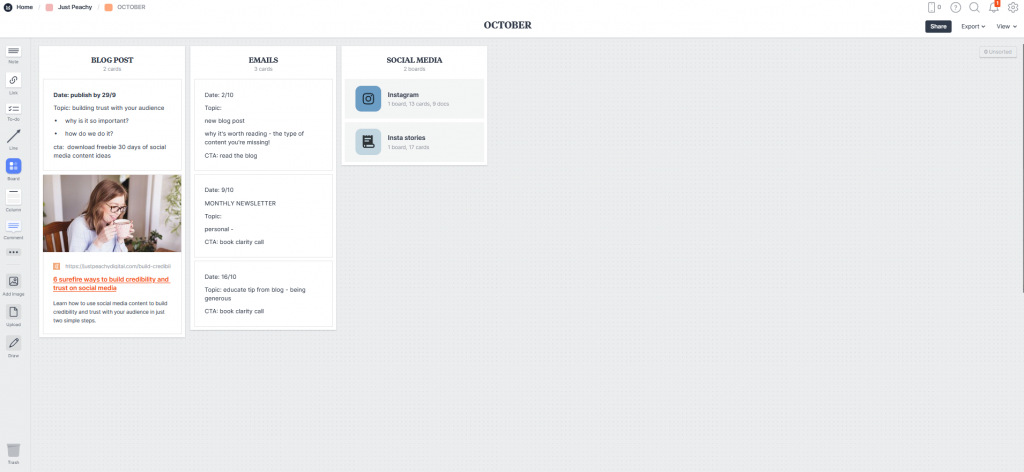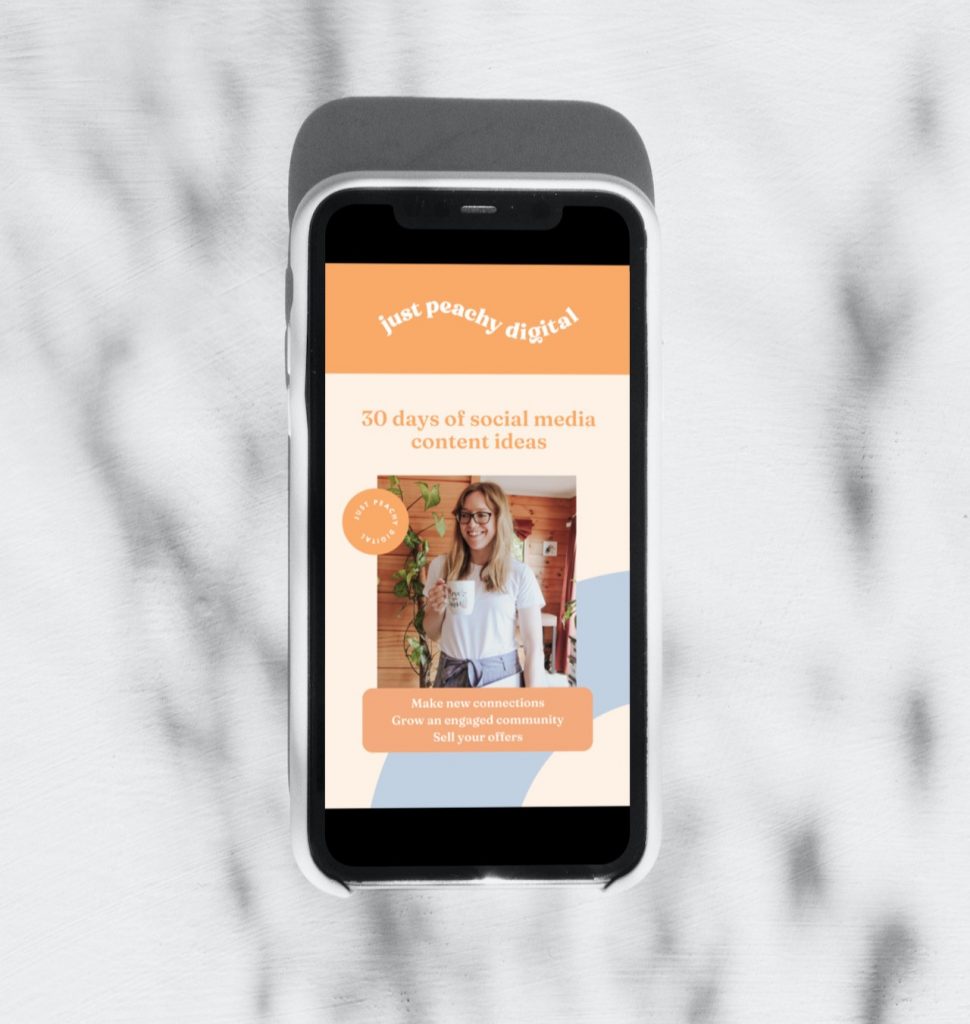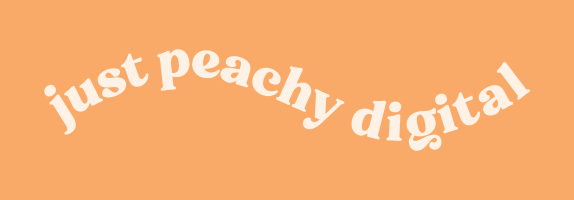The ultimate guide: how to plan social media content

If you’ve ever found yourself staring at your empty content calendar, wondering what the heck to post next, you’re not alone. It’s a struggle to constantly come up with fresh ideas to keep our social media profiles engaging. But that’s where this guide to help you plan social media content comes in!
In this blog post, we’ll cover everything from generating content ideas when you can’t think of anything to post, to the best way to organise your thoughts. And I’ll let you in on my tried and tested three-step content strategy that converts!
The best way to organise your ideas and plan content
The programme I use for all of my content planning is Milanote. It’s where I keep a running list of content ideas, an overview of all my monthly content and a draft of each post before I publish it.
What I love most about Milanote is that it’s basically a blank slate. Like a digital version of an empty notebook. It gives you total freedom to create boards and structure them however you like. It’s simple, easy-to-use and I’m not exaggerating when I say, I couldn’t function without it.
And another great feature of Milanote is that you can share boards between team members which is super handy for team projects.

How to generate content ideas when you can’t think of anything to post
Creative blocks are the absolute worst! Especially when you’ve set aside time to work on your content and you really need new posts ready to go as soon as possible. When I’m fresh out of ideas, here are a few ways I generate new content:
- Answer questions – crowdsourcing is an excellent way to get content ideas and create posts your audience actually want to see. Check your direct messages and comments to see if your audience has asked you any questions. Or you can pop a question box up on Instagram stories to allow your followers to send in their questions.
- Re-purpose popular content – take a look at which content has performed well in the past, then consider how you can re-purpose it. Maybe that’s using the post as inspiration, using it on another platform or expanding on it further to create a content series.
- Check what your audience are searching for – check suggested search terms on Google and Pinterest, and relevant Facebook groups. If you’ve set up Google Search Console, you’ll also be able to see a handy list of common search terms that lead people to your website.
Recommended reading: Download my free 30 days of social media content ideas guide!
The three types of content you need
When it comes to creating a solid social media content plan, there are three types of content you should be sharing.
Value-based content
The focus of this content is grabbing people’s attention and making connections. Posts are educational (tips, advice, resources) or personal (stories, facts, opinions etc).
Value-based content gets your audience thinking, “I like this person and what they’re sharing. I want to follow and see more!”
Credibility-building content
The purpose of this content is to position yourself as an expert, show that you know your stuff, and build trust. Posts highlight what people are saying about you (testimonials) and the successes people are experiencing through working with you (client stories).
Credibility-building content gets your audience thinking, “I trust this person. I like what they’re doing. I wonder if they could help me achieve that too?”
Offers-focused content
The purpose of this content is to invite people to work with you. Posts explain what your offers are, why someone should buy them, what’s unique about your process and why someone should take action now.
Offers-focused content gets your audience thinking, “This looks like exactly what I need! Sign me up thanks!”
How often should you post?
I’m asked this question all the time and I wish there was a straightforward answer. Unfortunately, there isn’t a perfect formula for how often you should be posting.
As social media feeds tend to move very quickly, even posting once a day wouldn’t be too much. But realistically, most of us don’t have the time to be creating THAT much content.
I recommend that you just do what is manageable and sustainable for you and your business. Keeping in mind that you want to share the best quality content and show up consistently.

Should you prioritise short form video or static posts?
No one content type or social media platform is better than another. The best option for your business depends on what you’re selling and who your ideal customer is.
If you’re trying to figure out whether to include short form video in your content plan, ask yourself these questions:
- What are your social media goals?
If you are working on brand awareness and aiming to reach as many new people as possible, short form video is a really great option for you.
- What content performs best for you?
Do your audience tend to engage and respond well to short form videos or is their another content type that gets better engagement for you?
- What do you have time for?
Between the planning, filming, editing and uploading, short form videos are time-consuming to create! If you are already struggling to keep up with creating content consistently, it might not be worth it for you.
- What do you enjoy creating most?
We all have different strengths which suit different types of content. If being on camera and delivering information in a brief, entertaining way is something you find fun, then absolutely keep up the short form videos.
Should you share more educational or personal content?
Educational and personal posts are both value-based content. And while these posts are helpful for reaching new audiences and making connections, it’s important that we balance them with the other two content types (credibility and offers.)
I find that often small businesses will overshare value-based content. They’ll be excellent at educating their audience but forget to talk about their offer or tell client stories that build trust.
How much personal content is too much?
Most of my clients struggle to share enough personal content. It can feel awkward and irrelevant to be talking about your personal life on your business profiles. But, personal content allows your audience to get to know you better. It makes you real and relatable.
Personal content doesn’t necessarily have to relate perfectly to your business/what your selling.
The key to great personal content is:
- It’s relevant to your audience. Make sure it’s something they care about. The only way you’ll know what this is, is by doing careful audience research to understand exactly who your ideal clients are.
- You provide an opportunity for them to engage. Ultimately, the goal of personal content is to drive connections and engagement. It’s actually not about you, it’s about your audience. Make your post about them (and therefore, interesting to them) by asking a question so they can share their thoughts.

How much content should you give away for free?
Often as online entrepreneurs we are afraid that we will give away too much of our knowledge and skills for free.
We are worried that if we share parts of our paid courses, workshops and e-books then people won’t want to pay for them.
It’s better to over deliver and delight your audience with how much value you bring than to leave them feeling underwhelmed by you.
In fact, I don’t think you should worry about giving away too much value for free at all.
- You want to constantly wow your followers with your knowledge, advice and insights.
- You want to go above and beyond for those potential customers.
- You want them to think ‘woah if her free content is this good…how great must her paid content be?’
Don’t be afraid of showing up and sharing what you know!
free Social media content plan

I know how draining it can be when you feel like there is never enough time in the day for all the marketing you need to do. Which is why I put together this guide to help you!
I’ll show you how to plan content for social media that connects with your dream clients, positions you as an expert and helps you make more sales.
Fill out the form below, pop the kettle on and cosy up with a cuppa to start planning your content…
